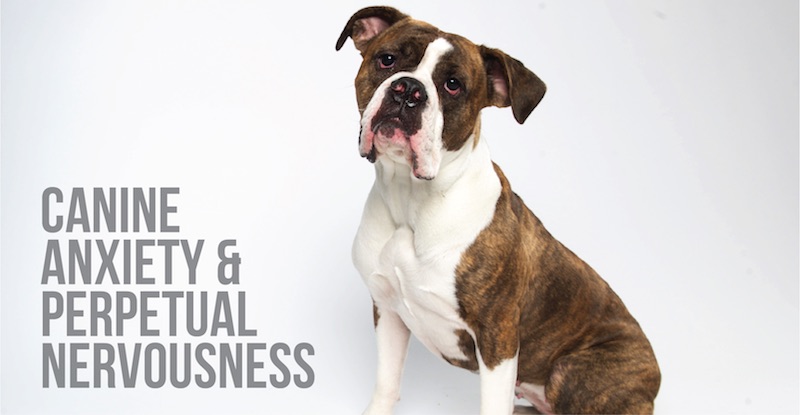
We've been there...
You come home from a long day of work, ready to pop your feet up and relax with your pooch. As you crack open the door, your heart almost falls out your butt…
Stuffing. Everywhere.
Three pairs of shoes in pieces.
Carpet fibers sprinkled about like confetti.
Couch corners shredded.
Everything you love and hold dear ripped out from under you in just a few short hours.
You stand in disbelief, regretting you ever fell for the cold-hearted lie that your dog was ready to chill at home crate-free.
Then your eyes meet the guilty (but oh-so-cute) eyes of the fluffy felon. He sits so patiently in the middle of his ruthless destruction, fearlessly maintaining eye contact, even mustering up the audacity to subtly wag his tiny tail. And all you can manage is a quiet, defeated whisper:
“Why?”
For many of us, this scene is painfully familiar. You may even cringe at the thought of a past traumatic experience. And even after all these months, it still eludes you as to why your dog would do such a thing.
“Was it out of spite?”
“Was he getting back at me for something?”
“Did he just forget his training for a little bit?”
Don’t take it too personally, though. In reality, it was likely none of these things – he was probably just bored.
Dogs and Boredom
When your dog is bored, he may exhibit a number of inappropriate coping behaviors: barking, destructive chewing, digging, accidents, etc. And while human kids may not deal with their boredom by barking at outside passersby, dogs actually have a lot in common with kids when it comes to boredom.
It often stems from a surplus of energy, but a shortage of exercise or activity.
Dogs, like humans, enjoying being physically or mentally stimulated and when they go for prolonged periods without any sort of challenge, they look for other means of entertainment. The more times your dog is left unattended and bored, the more likely he will get into something he shouldn’t. So before we lash out at dogs for chewing our favorite pair of sneakers, maybe we need to reflect a little on our own daily routine to determine whether we’ve been providing an adequate amount of exercise (both mental and physical).
Think of it like this. If you were watching a child, and you left them alone in a room with a stack of really important documents, permanent markers, eggshell white walls, and then a toy truck, what would you expect to happen? Exactly. This is essentially what you’re doing as you leave your dog in the living room with just a bone, expecting everything to work out flawlessly. It’s not going to happen (at least consistently, it won’t). You may get lucky a few times, but if you keep leaving your dog in the same environment, with the same toy, every day for 8 hours a day, he will eventually find new things to chew on.
Enter: The Solutions
1. Exercise him
Ever heard the saying “A tired dog is a well-behaved dog?” Dogs who are frequently and consistently exercised will have less pent up energy (energy they would normally use to dig up the carpet). They will feel more physically satisfied, which may help them to nap more and bark less while you are away. Better yet, if you can establish a routine of exercise (ie – a walk before work, a game of fetch after work, and maybe a trip to the park every Monday and Thursday evening), your dog will begin to trust that he will have guaranteed time for play later, so he doesn’t need to eat the fake fruit centerpiece now.
2. Challenge him
Beyond just physical exercise, your dog also needs mental stimulation. This can be in the form of training, cognitive toys, or toy rotation. Training is a form of learning, which is always helpful to a dog’s mental health! Training for tricks, or just training for socialization can help your dog to focus in on a specific task, effectively exercising his brain. Take a couple minutes out of your evening to work on a new trick, or practice some old tricks to keep your pup’s mind from boredom.
Toys are also a great tool for mental stimulation. There are plenty of dog toys on the market that can challenge your dog, even when you aren’t around to play with him. Toys that force your dog to work for a reward or that incorporate more than just one of his five senses are great for keeping play interesting. And if you don’t have the budget for new toys every week, try toy rotation. Just leave out a few different toys every day so he always has something different than he did yesterday.
3. Socialize him
If your dog gets along well with other dogs, maybe you should consider a couple days of doggy daycare. While every day may be a little too much for your dog, once or twice a week of a new environment with some new faces may be just enough of a break from daily routine that your pup doesn’t get bored. Plus, the exercise from one day can help your dog to use the next day or two to recover at home (peacefully and nondestructively).
This may not be a viable solution for all dogs, but if you find that your dog is enjoying himself and seems excited to go to daycare in the morning, it may be a great solution for keeping your dog mentally and physically exercised. For non-social dogs, perhaps a trusted dog walker may be a better alternative for some daily exercise.
Don't jump to conclusions too fast...

You May Also Like: Canine Anxiety & Perpetual Nervousness
While most dogs have experienced occasional nervousness, there are dogs and cats out there who have perpetual anxiety. For more on dealing with this kind of nervousness, check out this post.



